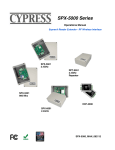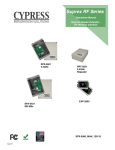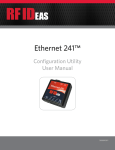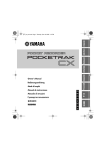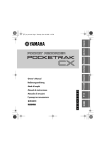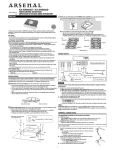Download Cypress Suprex WMR-9600MAN Specifications
Transcript
! CYPRESS */5&(3"5*0/40-65*0/4 WMR-2000 SYSTEM ! ! ! Operations Manual Wireless Mobile Reader ! WMR-2000-V3_MAN_0314 System Overview! ! Cypress’ Wireless Mobile Readers provide a unique portable credential verification solution. The WMR system includes a wiegand or serial panel interface for real-time verification. Common applications include Assembly Attendance, Random Challenge, Mustering and High volume Cardholder Traffic logging Other common credentialing challenges can be easily solved with the WMR series of solutions. Designed for Transportation and Cargo Facilities, Petrochemical and Manufacturing Facilities, Healthcare and Educational Campuses. Physical Specifications! ! Handheld Reader -8.25” x 5” x 2” - 1.5 lbs ( with batteries - not included )! Base Unit - 6.75” x 3.75” x 2.00” - 1.0 lb! ! ! Environmental Specifications! - Temperature Range -40 to 85 C! Central Unit! - Supply Voltage! ! - Current! ! ! ! ! ! ! Electrical Specifications! ! ! 8-16VDC! 300mA! Handheld Unit! - 4 X AA Batteries Alkaline or NiMh ( not included )! Smartcharger! - Smartcharger for NiMh batteries ! Frequency! ! ! Type !! ! ! Transmit Power! ! Receive Sensitivity!! Security encryption! ! ! ! ! 120 VAC wall plug! Radio Specifications:! ! ! ! ! ! ! ! ! ! ! ! ! 2.4 GHz ISM band! Direct Sequence Spread Spectrum! 15 dBm! -103 dBm! AES encryption upon request (export restrictions apply)! ! ! Card Technologies - Ordering Information! ! One Reader Configuration! Includes Base unit, holster, charger and lanyard! WMR-2120 !! ! ! Farpointe Prox - HID Prox (125 kHz)! WMR-2130! ! ! ! HID Multiclass - iClass and MiFare CSN (125 kHz and 13.56 MHz)! WMR-2160! ! ! ! HID SE - iClass and MiFare (13.56 MHz)! Two Reader Configuration! Includes Base unit with Wiegand port expander, (2) holsters, (2) chargers and (2) lanyards! WMR-2220 !! ! ! Farpointe Prox - HID Prox (125 kHz)! WMR-2230! ! ! ! HID Multiclass - iClass and MiFare CSN (125 kHz and 13.56 MHz)! WMR-2260! ! ! ! HID SE - iClass and MiFare (13.56 MHz)! *Other technologies available upon request! ! ! ! ! Typical wireless range: ! - Internal - Up to 150 feet ! ! - Outdoor - Up to 250 feet (Distances given are typical line of sight. Actual distance will vary depending upon terrain, RF environment, building materials, and height of antenna).! * Range may be expanded using RPT-565X repeaters. Unpack Units RPT-5651! Optional Repeater WMR-7211 Base Unit WMR-7XXX Mobile Unit WMR-BATT-NiMH Belt Holster! WMR-HOLB WMR-PRCX! Programming cards! (if required) Smartcharger for NiMH Batteries (not included) Wiegand Expansion ! EXP-1000C Remove cover from Central unit and check interior for any shipping damage. ! Remove any packing material if present.! ! Before installing the units in the field they should be assembled and tested at a convenient “Bench top” location. This will make it easier to verify / change settings and check operation when both units are visible at the same time. ! ! It is also a chance to become familiar with the system if this is the first time using the Suprex system. It is much more difficult to configure and test the units when they are several hundred feet apart.! ! The units as shipped are configured as a matched pair/set and are ready to plug in and operate.! ! The Central unit needs to have a suitable power supply installed. ! System Description The Wireless Mobile Reader is the newest member of the Suprex family of products.! ! The WMR products are based on the Suprex SPX-5600 series of products and they support a wide range of additional features:! ! Additional features:! ! -- AES Encryption for secure communications upon request! -- No channel selection is required as the units are preconfigured at the factory.! -- Diagnostic indicator on Central unit for determining operational status of the unit! -- Repeaters for challenging installations for additional distance and line-of sight! ! Initial setup and configuration.! ! The Wireless WMR system operates as a matched pair of units that share the same communication channel. Each pair is configured at the factory to operate without the need to set channels.! ! Each pair communicates using an intelligent addressing algorithm. This allows multiple pairs of units to operate in the same environment without interfering with each other.! ! Up to 8 units can operate in the same area without factory modifications ! ! Unit channel selection is made at the factory and no field settings are necessary. ! ! ! Initial Setup:! ! This manual will cover the basic installation procedure for a typical Suprex WMR system.! ! The first step will be to configure and test the units at a bench top location where both the Central and Remote units are close together. This will allow the setup and configuration process to occur with both sides of the operation in view.! ! Setup is modified minimally when using EXP-1000 units. Please make note.! ! See the Address programming Addendum when using multiple Handheld Readers with EXP-1000 wiegand expansion units Credential Read Area Communication ! Status LED! BLUE Lanyard Post Card! Verification LED! GREEN Power LED! and Card Acknowledge! RED Power Button Grip Colors Charging Port ! with weatherproof cover Case Colors ! Operation:! ! The Handheld Remote reader unit will read a Wiegand RF proximity badges. The badge data is sent! through a radio link to a Central panel interface module that generates Wiegand data for a connected access control panel.! ! An access control panel determines whether the badge is valid or invalid. When valid badge data is presented, the panel will trigger either an LED, Strike Relay output, or both, depending upon the type of panel. Any low (Ground) connection on the Central LED input will change the state of the Remote status LED from Red to Green. The Central unit LED input is connected to the panel output and the status of this panel output is what is displayed by the Remote status LED. The panel also determines the amount of time the LED remains Green for valid badges.! ! A Central unit diagnostic LED will alternate Red and Green when the units are not communicating. This may be happen when the Central unit powers up without the Remote unit having power. Once both units are powered up, the Central Unit diagnostic LED should enter a flashing green on and off mode. This should occur within 30 seconds of both units having power applied.! ! The Remote unit Communication LED should also be flashing rapidly when the units are! communicating.! ! User operation:! When successfully linked to the WMR-7211 base unit, The WMR handheld unit should have the communication LED flashing BLUE 3 times per second, and the Power LED (RED) during idle operation.! ! When a badge is presented the WMR handheld unit will beep to indicate that the badge was read (sensed). Additionally the Power LED will flash off (RED).! ! The Status LED will remain Red for invalid badges, and will change to Green for valid! badges and valid badge verification includes a vibrate feature.! ! After an amount of time determined by the panel, the Status LED will return to a Red! state. External connections and DIP Switch Settings ! 1 - 8 to 16 VDC In ! 2 - Ground ! 1- Relay 4 N.O.! 2- Relay 4 Com! 3 - Relay 4 N.C.! 4 - Relay 3 N.O.! 5 - Relay 3 Com! 6 - Relay 3 N.C.! 7 - Ground ! 8 - Aux out! 9 - R2 in! 10 - R1 in WMR-7211! Central 1 - exp (+)! 2 - exp (-)! 3 - +5 VDC out! 4 - Prog Res 2! 5 - Prog Res 1! 6 - LED In ! 7 - D1/Data out ! 8 - D0/Clk out Central Unit Settings DIP Switch #1 ON ! -Service Mode! DIP Switch #1 OFF! -Run Mode Switch! 6 7 8 Wiegand Wiegand / No Filter O O O! O O X 1 2 3 4 5 6 7 8 Dip switch #4 is ON -Disable Pullup resistors Dip switch #4 is OFF -Enable Pullup resistors WMR-7211 Central Quick Reference DC! Power ! Supply! +8 to +16 VDC! Ground Diagnostic LED Access! Control ! Panel! WMR-7211! Central R1 Input ! Controls ! Strike on! Remote LED In! D1/Data Out! D0/Clock Out R1 IN ! Cypress WMR-2000 - Wiegand Expansion Module! Panel “Central” interface DC! Power ! Supply +8 to +16 VDC! Ground EXP(+)! EXP(-)! WMR-7211! Central ! ! ! Access! Control ! Panel LED In D1/Data Out! D0/Clock Out 8 to 16 VDC In! Ground 485(+)! 485(-)! +5 VDC Out! Prog Res 2! Prog Res 1! LED Input! D1/Data/F2F Out ! D0/Clock Out * EXP-1000! Central Unit R1 IN RLY4 N.O.! RLY4 Com! RLY4 N.C.! RLY3 N.O.! RLY3 Com! RLY3 N.C.! RS232 Out! RS232 In! Ground! Aux Out! Relay2 Input! Relay1 Input R1 Input ! Controls ! Strike on! Remote WMR-7211 Central Unit Diagnostics and programming ! Channel! Selection Address ! Selection LEDs RF Module 1234 DIP Switch 567 2 3 4 All Off 5 1 2 3 4 5 6 7 8 9 10 6 7 Display 8 9 Signal Strength Meter 10 bm to 0d db m to 12 -2 0 db 13 -4 0d bm bm m bm -2 0 -4 0d to -6 0d bm 0d bm m db to -6 0d -8 -9 0d bm to N o -8 0 Si gn al 11 14 WMR-7211 and EXP-1000 Cable Recommendations! ! RS-485 connection (WMR-7211 to EXP-1000 )! PVC - Belden 9744 - 22 AWG 2 twisted pair, 4,000 feet max.! Plenum - Belden 82741 - 22 AWG 2 twisted pair, 4,000 feet max.! ! Wiegand and LED! PVC - Belden 9873 - 20 AWG 3 pair shielded, 500 feet max.! Plenum - Belden 83606 or 85164 - 20 AWG 3 pair shielded, 500 feet max.! ! Power (local)! PVC - Belden 8461 - 18 AWG 1 pair, 25 feet max.! Plenum - Belden 82740 - 18 AWG 1 pair, 25 feet max. Typical RF installation with repeater WMR-71XX Obstruction ACS 0 1 2 WMR-7211 RPT-5651 Typical RF installation - line of sight! WMR-21XX configuration ACS WMR-71XX WMR-7211 Typical RF installation - ! expansion modules! ! WMR-22XX configuration WMR-71XX WMR-7211 ACS EXP-1000C (2) ! CYPRESS */5&(3"5*0/40-65*0/4 WMR-2000 Series! ! ! Wireless Mobile Reader Kit Product Specifications! WMR-2000-V3_SS_1013 ! Physical Specifications! ! Handheld Reader -8.25” x 5” x 2” - 1.5 lbs ( with batteries - not included )! Base Unit - 6.75” x 3.75” x 2.00” - 1.0 lb! ! Environmental Specifications! - Temperature Range -20 to 50 C! ! Electrical Specifications! Central Unit! - Supply Voltage! - Current! ! ! ! ! ! 8-16VDC! 300mA! Handheld Unit! - 4 X AA Batteries Alkaline or NiMh (12 hours with (4) 2600 mAh)! ! Smartcharger! - Smartcharger for NiMh batteries ! 120 VAC wall plug! ! Radio Specifications:! Frequency! ! Type ! ! ! Transmit Power!! Receive Sensitivity! ! ! ! ! ! ! ! ! ! 2.4 GHz ISM band! Direct Sequence Spread Spectrum! 15 dBm! -103 dBm! Security encryption:! - Wireless communications! ! ! ! ! ! ! ! ! AES encryption upon request (export restrictions apply)! ! Card Technologies - Ordering Information! One Reader Configuration! WMR-2120 ! WMR-2130! WMR-2160! ! ! ! ! ! ! ! ! ! Farpointe Prox - HID Prox (125 kHz)! HID Multiclass - iClass and MiFare CSN (125 kHz and 13.56 MHz)! HID SE - iClass and MiFare (13.56 MHz)! Two Reader Configuration! WMR-2220 ! WMR-2230! WMR-2260! ! ! ! ! ! ! ! ! ! Farpointe Prox - HID Prox (125 kHz)! HID Multiclass - iClass and MiFare CSN (125 kHz and 13.56 MHz)! HID SE - iClass and MiFare (13.56 MHz)! ! *Other technologies available upon request! ! Typical wireless range: ! !- Internal - Up to 150 feet ! ! ! - Outdoor - Up to 250 feet (Distances given are typical line of sight. Actual distance will vary depending upon terrain, RF environment, building materials, and height of antenna).! ! * Range may be expanded using RPT-565X repeaters. Cypress Computer Systems, Inc. ⌖ Lapeer, MI 48446 ⌖ www.cypresscomputer.com © 2014 Cypress Computer Systems Inc. ADDRESS PROGRAMMING ADDENDUM! The handheld units are shipped preconfigured for use with their respective Central Units. One Handheld is designated as "Out Bound" and has the polling address of 0 (zero). Another is labelled as "Inbound" with address 1. And the third handheld is set up as a spare unit with a polling address of 2 (not in the central unit's polling sequence).! ! At any time, the spare can be easily re-configured to take over for the In or Out handheld device by using special programming cards (included with your units). All units will recognize the 3 programming cards (they are not restricted to a particular set or group of handhelds).! ! The programming cards ( PART NUMBER WMR-PRCD) are labeled Address 0, 1, and 2.! ! Change the spare unit to take over for the outbound handheld reader:! 1. Turn the spare handheld on by pressing the power button momentarily! 2. Observe the Red Led is on solid.! 3. Present the Programming Card labelled Address 0! 4. Observe the Red Led wink for 1/2 second indicating the card was read (there is also an audible beep)! 5. The Blue Led should start blinking every second indicating that it is communicating with the Central Unit! 6. The Handheld is now ready to be used as the OutBound Handheld Reader! ! ! Change the spare unit to take over for the inbound handheld reader:! 1. Turn the spare handheld on by pressing the power button momentarily! 2. Observe the Red Led is on solid.! 3. Present the Programming Card labelled Address 1! 4. Observe the Red Led wink for 1/2 second indicating the card was read (there is also an audible beep)! 5. The Blue Led should start blinking every second indicating that it is communicating with the Central Unit! 6. The Handheld is now ready to be used as the InBound Handheld Reader! ! ! ! Take a handheld out of service: 1. Turn the spare handheld on by pressing the power button momentarily 2. Observe the Red Led is on solid. If not, the batteries may need to be replaced or charged. 3. Present the Programming Card labelled Address 2 4. Observe the Red Led wink for 1/2 second indicating the card was read (there is also an audible beep) 5. The Blue Led should stop blinking and remain solid (or stay off) indicating it is no longer in contact with the Central Unit 6. The Handheld is no longer being polled by the central and will not interfere with normal use of the other 2 units ! ! For all steps indicated above, the following error conditions may occur. ! Step 2 - If the Red LED does not illuminate, the batteries may need to be replaced or charged. Step 4 - If you do not see the Red LED wink out for 1/2 second, present the badge again. - If the Red LED still does not indicate a badge read has occurred, then there may be a problem with the reader. - When trying multiple times, make sure the badge is well away ( greater than 1 foot) from the handheld before presenting the badge again. - Allow the unit to power off (1 minute) and try again. Step 5 - If the Blue LED does not start blinking within 10 seconds after presenting the In or Out programming card, make sure the Central Unit is powered on and is within communication range. After presenting the "Out of Service" card (Address 2), the Blue LED should stop blinking within 10 seconds. If it continues to blink, the Central Unit may not be configured properly. ! ! WMR Channel Programming ( future )! ! ! The New WMR handheld units will provide for field selection of Channel (2 - 14) and Network address ( 0 - 3 ) using programming cards.! ! Address program cards will be used for programming IN and OUT readers.! ! Sample Channel card! ! ! ! ! ! ! ! ! ! ! ! Sample Address cards! ! ! ! ! ! ! ! ! ! ! Additionally the New WMR base units will offer field programing using dip switches. Signal strength metering will also be available to assist with hardware placement during installation.! ! See additional documentation. ! Routine Maintenance and Trouble Shooting
















